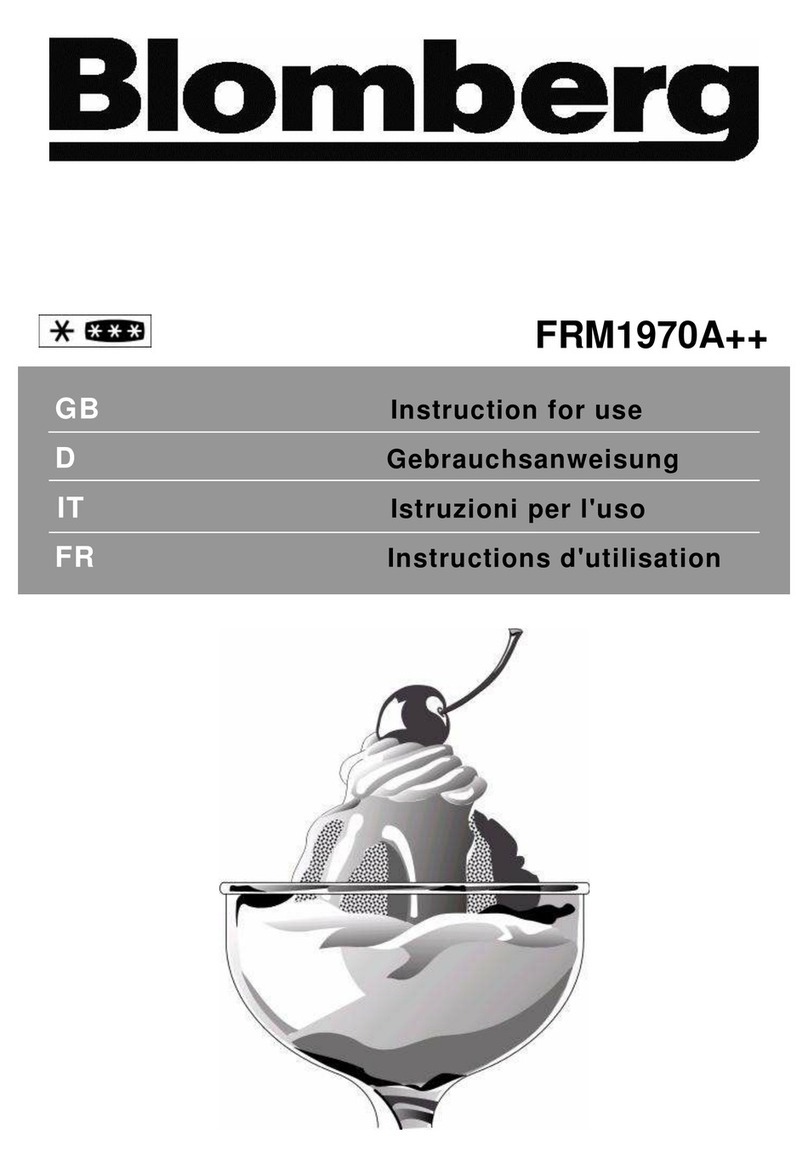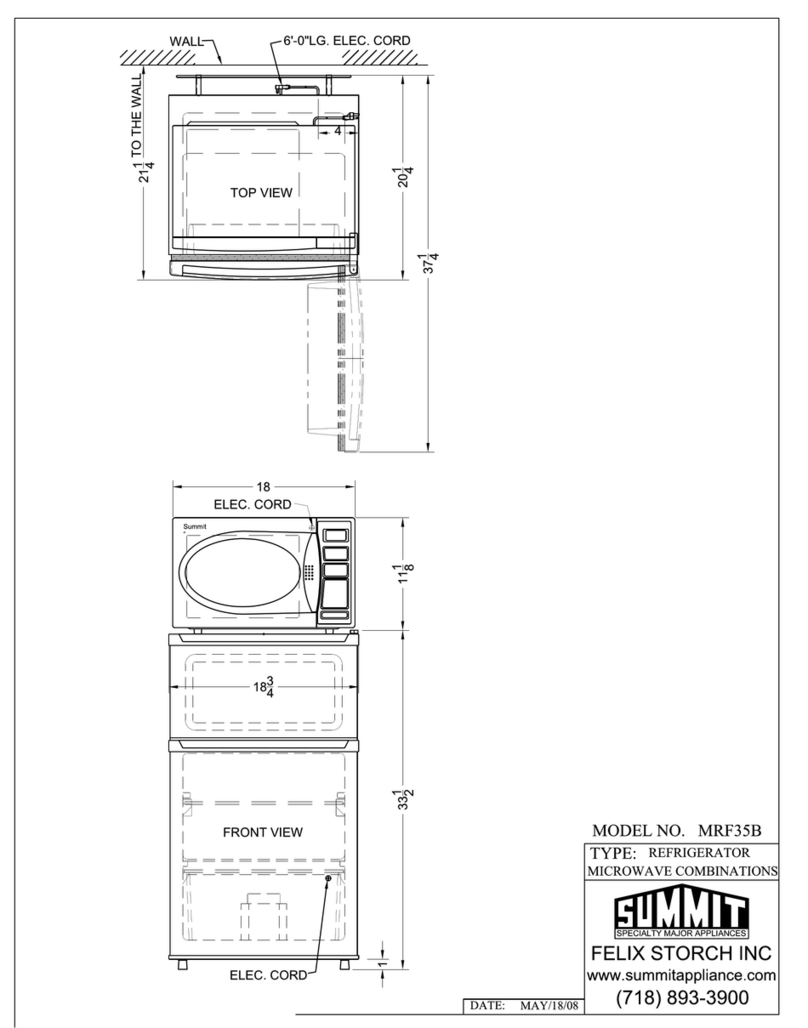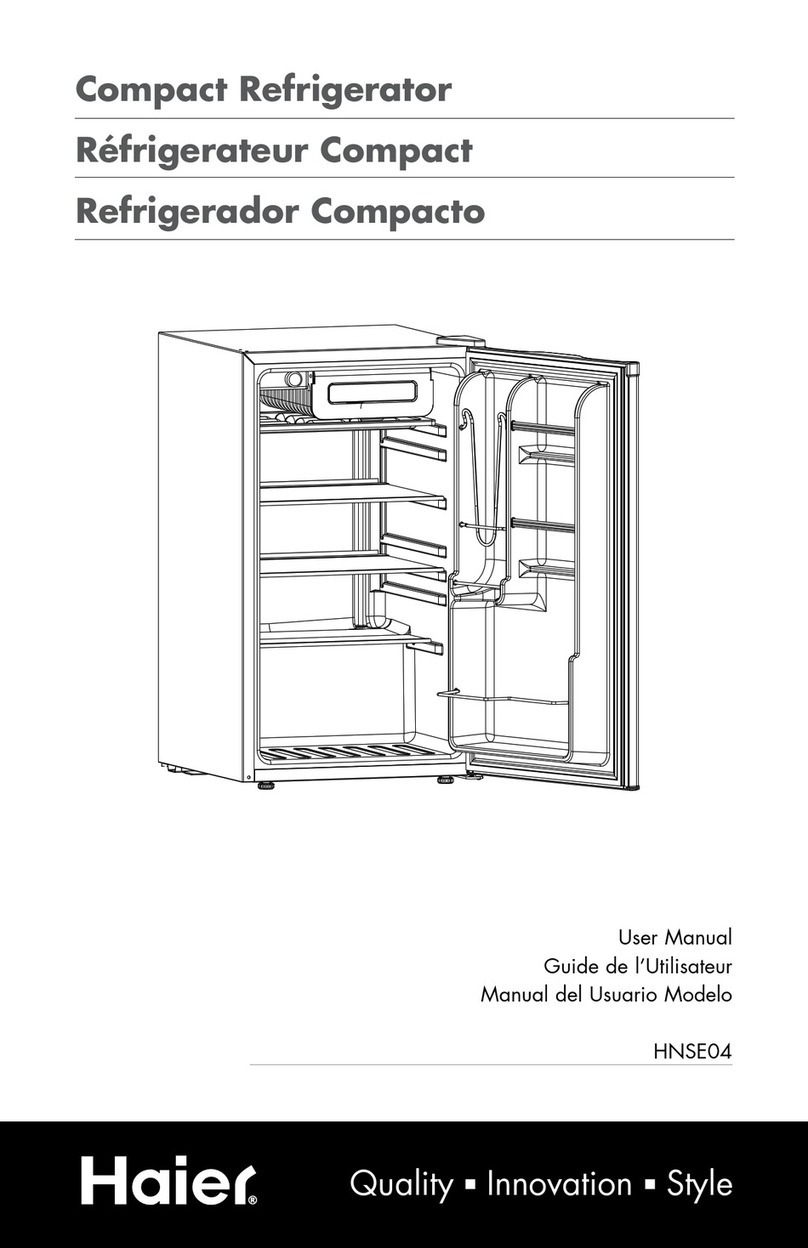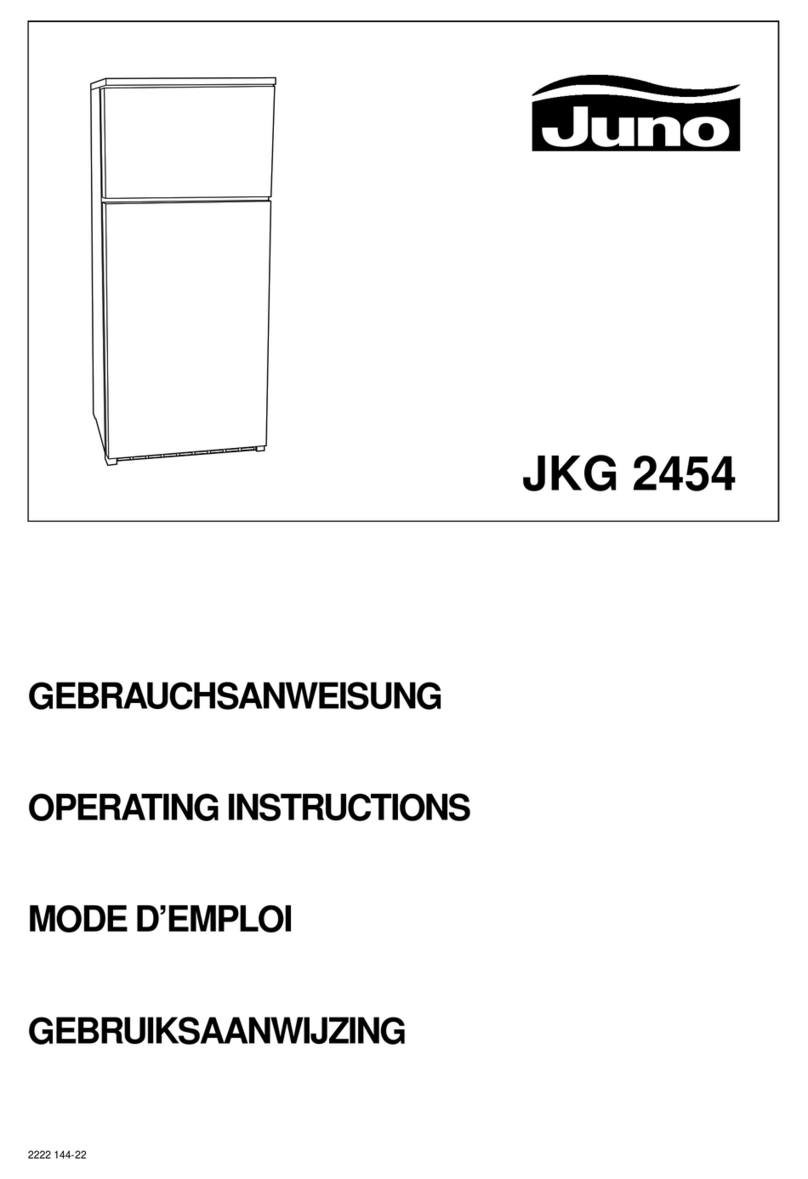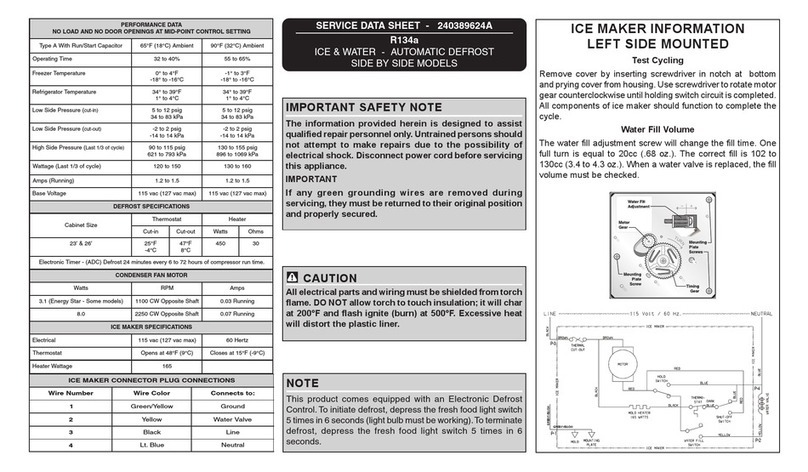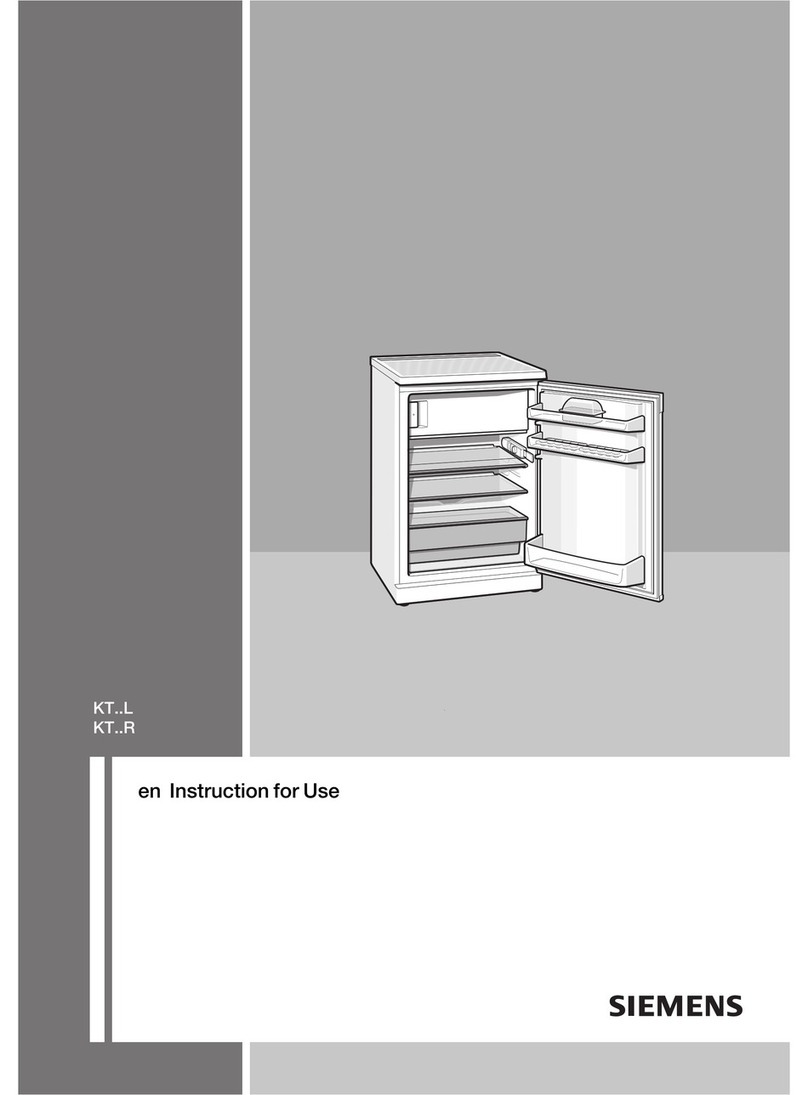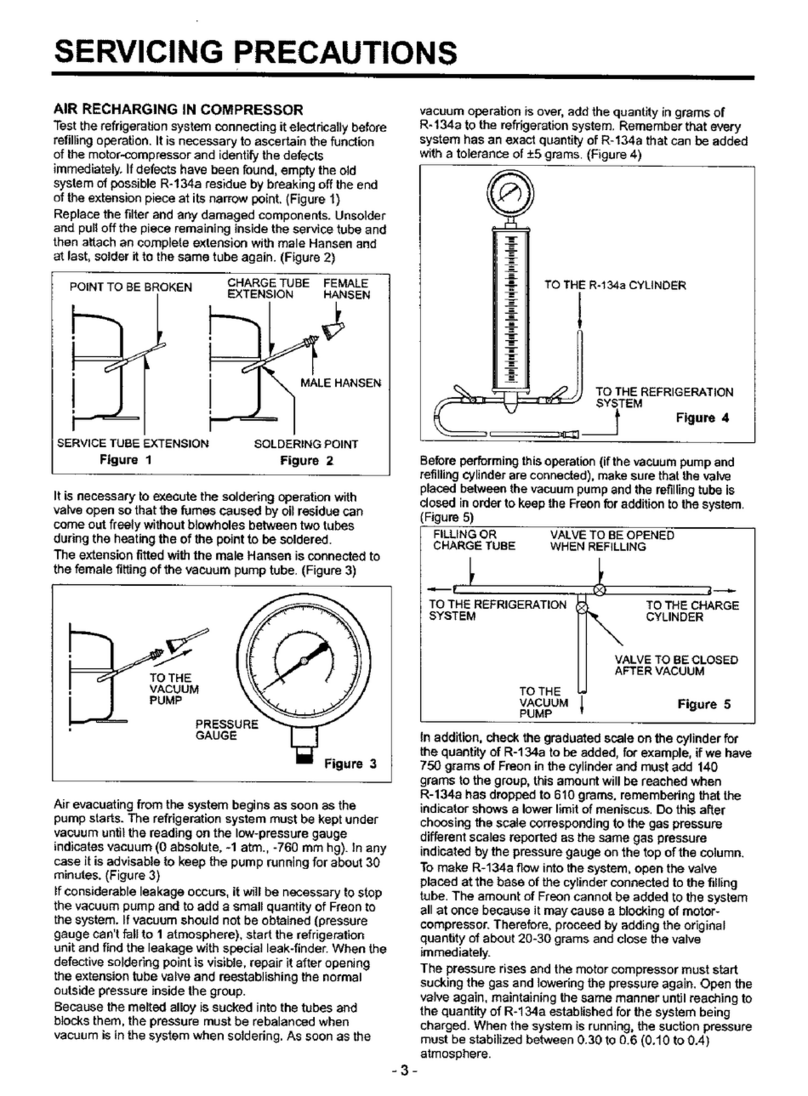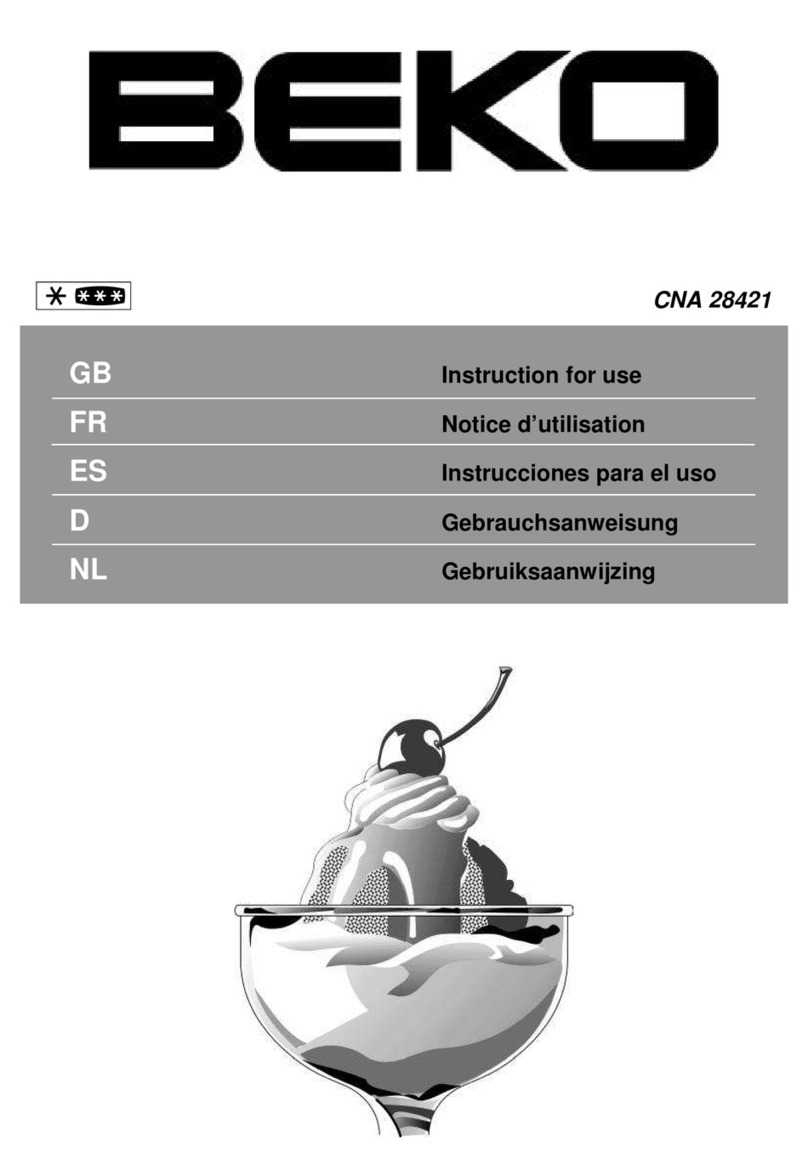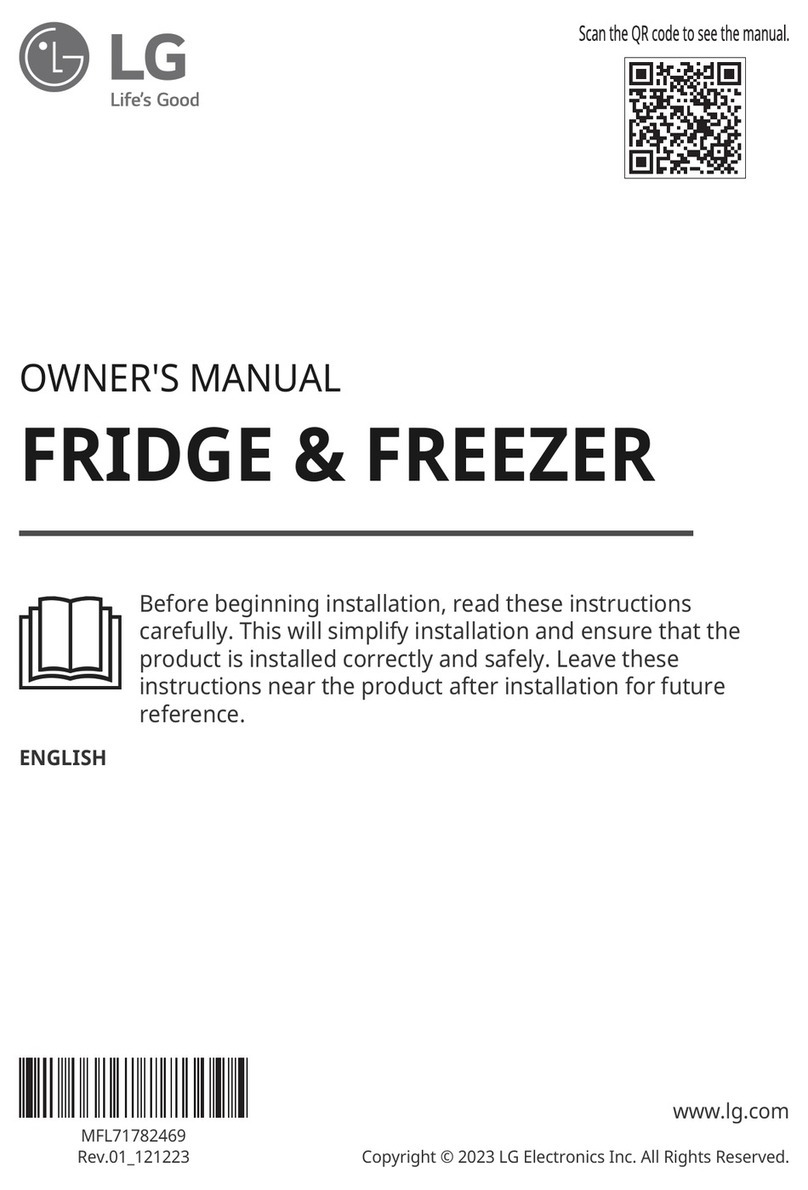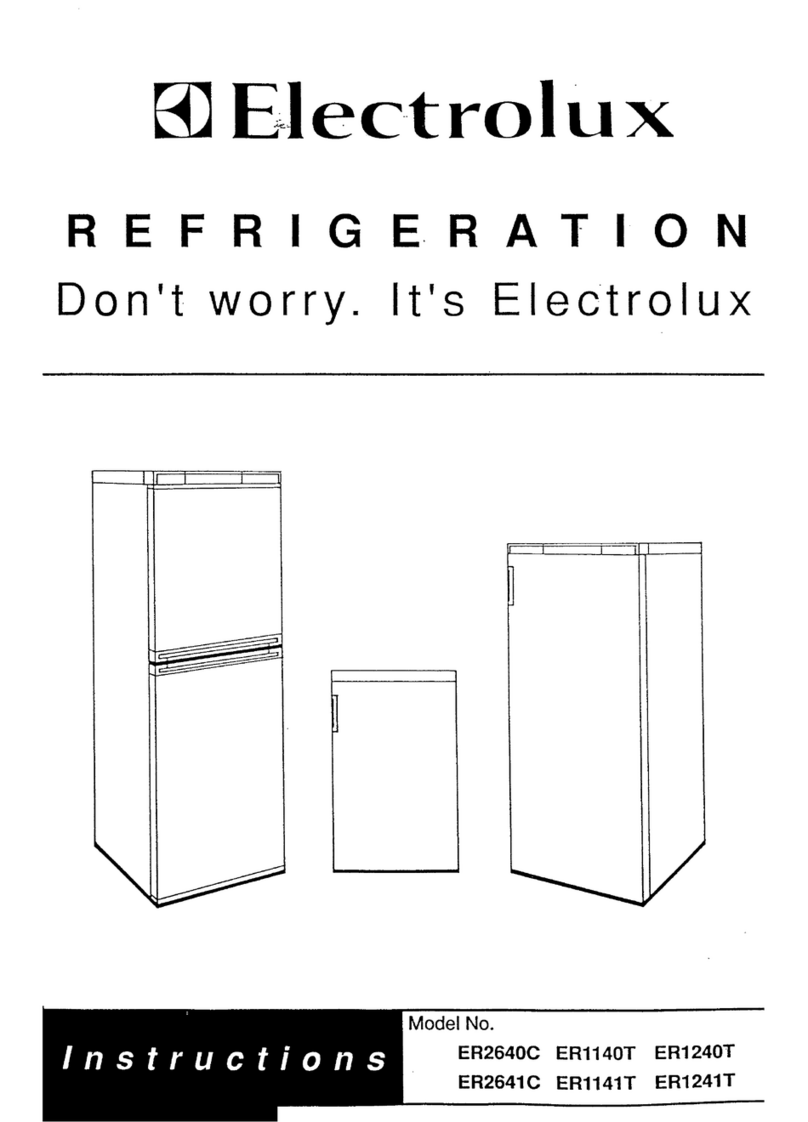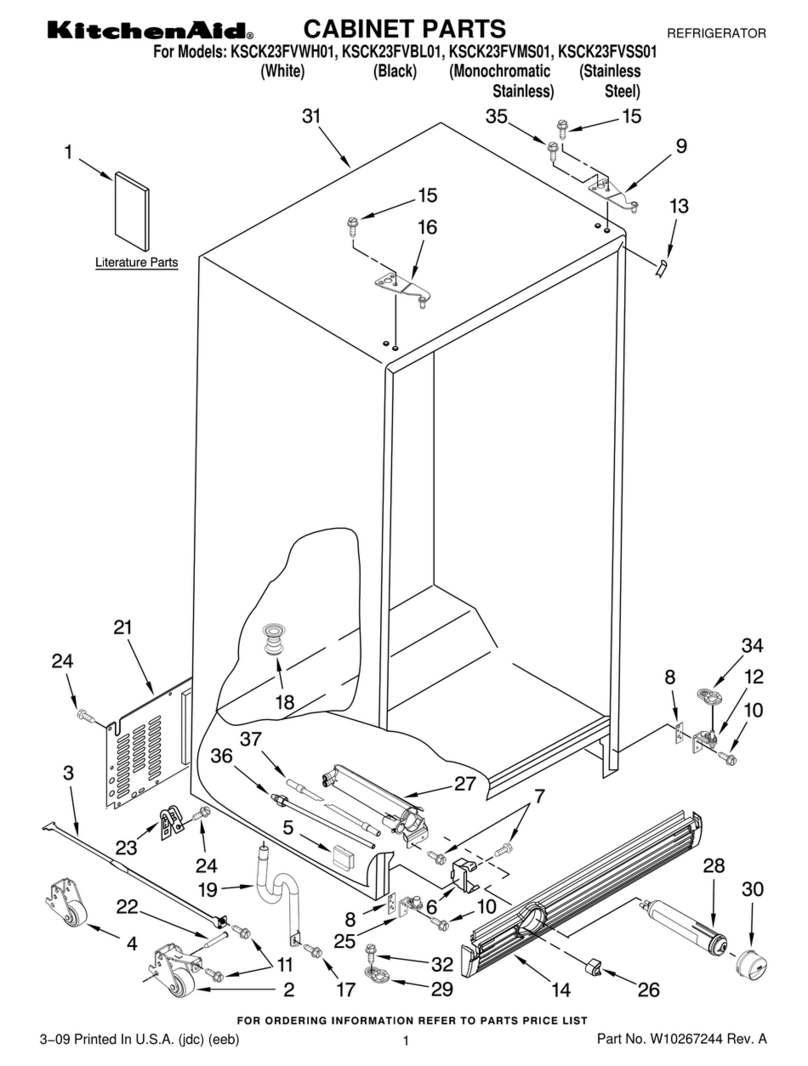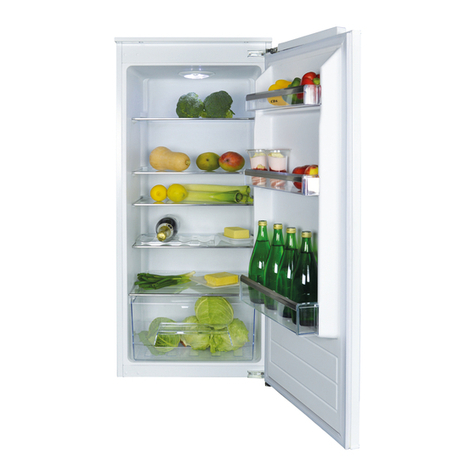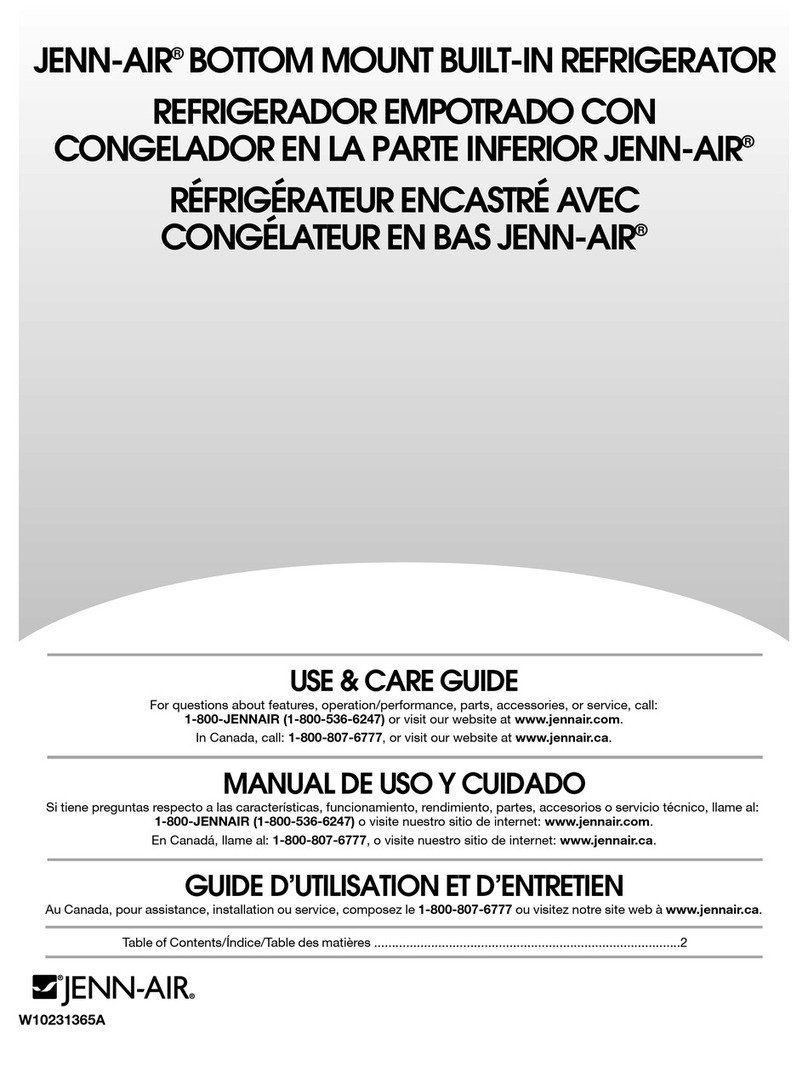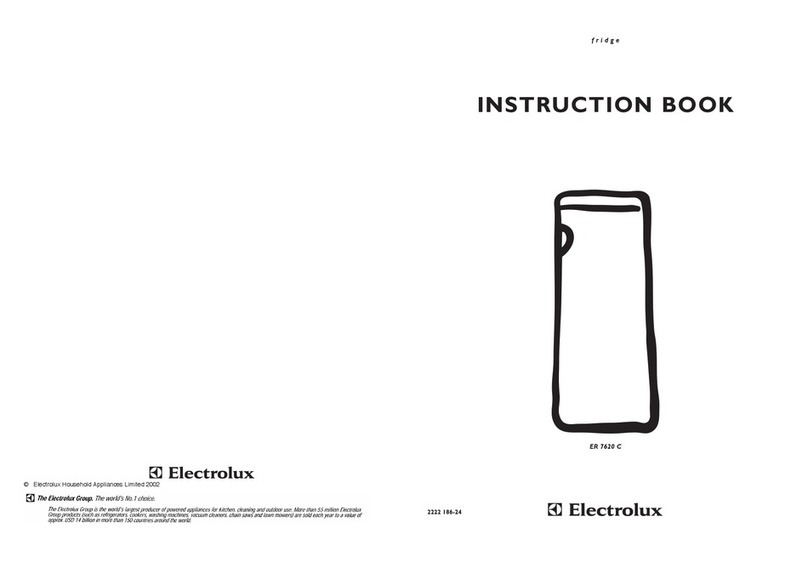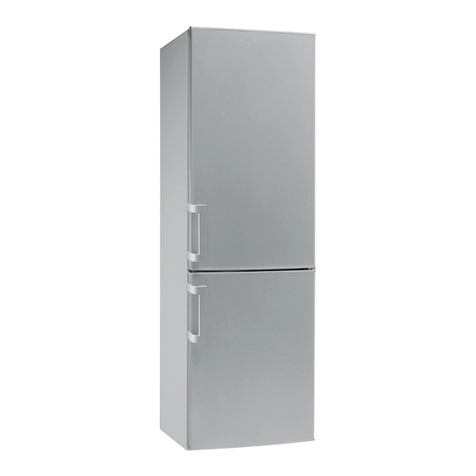ProWine PF156GWAS User manual

55cm Under Counter Fridge
MODEL: PF156GWAS
PF156GWAB
INSTRUCTION MANUAL

Namesofparts
1
1. Top Cover
2. Freezer Door
3. Freezer Door Handle
4. Glass Shelf
5. Crisper Box Cover
6. Crisper Box
7. Leveling Legs
8. Lower Door Shelf
9. Upper and middle door shelves
10. Recessed handle
11. Door switch
12. Thermostat and lamp assembly

THANK YOU FOR PURCHASING THIS PROLINE PRODUCT
This booklet contains the information you will require to install and operate your new
appliance.
It is important and worthwhile spending time to fully read this booklet so you will
understand how to operate the appliance safely and efficiently.
Please keep this booklet in a safe place so that you can refer to it when required.
ELECTRICAL CONNECTION (UK ONLY)
For your safety please read the following information.
Warning: This appliance must be earthed.
The appliance must be connected to a 240 volts 50 cycle AC supply by means of a three
pin socket, suitably earthed and should be protected by a 13 amp fuse in the plug.
The appliance is supplied with a standard 13 amp 3-pin plug fitted with a 13-amp fuse.
Should the fuse require replacement, it must be replaced with a fuse rated at 13 amp and
approved to BS1362.
If the mains plug is unsuitable for the socket outlet in your home or is removed for any
other reason, then the cut off plug should be disposed of safely, do not insert the cut off
plug into a mains outlet to prevent the hazard of electric shock. Remove the fuse before
disposal.
There is a danger of electric shock if the cut off plug is inserted into any 13-amp socket
outlet.
How to wire a 13 amp plug:
Important
The wires in the mains lead on this appliance are colored in accordance with the following
code:
Green and Yellow - Earth
Blue – Neutral
Brown – Live
As the colours may not correspond with the markings identifying the terminals in your plug
proceed as follows.
The green and yellow wire must be connected to the terminal in the plug which is marked
with the letter E or with the earth symbol or colored green and yellow.
The blue wire must be connected to the terminal marked N.
The brown wire must be connected to the terminal marked L.
You must make sure the mains cord is firmly secured under the cord clamp.
2

3
REFRIGERATOR SAFETY INFORMATION
Check that the voltage marked on the rating plate matches that of your local supply.
Failure to use the correct voltage will render the guarantee VOID and may cause damage to
the appliance.
The manufacturer accepts NO responsibility for using any other voltage than that marked on
the rating plate.
This appliance is intended for domestic use only; any other use may invalidate the warranty
and might be dangerous.
This appliance is intended for indoor use only, do not use or store outdoors. This appliance
shall not be exposed to rain.
The mains plug shall be the main disconnect device and shall remain operable at all times.
A short power-supply cord is provided to reduce the risk of a tripping hazard.
To disconnect from the mains completely, turn the appliance OFF, then remove the plug from
wall outlet.
Do not immerse the appliance, its lead or plug in water or any other liquid.
Remove all food and unplug from the supply when not in use and before cleaning the
appliance.
If the mains lead becomes damaged, it must be replaced by the manufacturer, its service
agent or similarly qualified person with a specially prepared lead of the same type and rating
to avoid a hazard.
Do not operate the appliance with a damaged cord or plug or after the appliance malfunctions
or has been damaged in any way.
Do not let cord hang over edge of the surface, or touch hot surfaces.
Do not place the appliance on or near hot surfaces, or in direct sunlight.
Children must be supervised to make sure they do not swing on the door.
Accessible surfaces may get hot when in use, use handles and knobs at all times.
Always attach a plug to the appliance, and then plug it into the wall outlet and switch on.
If you are discarding an old appliance with a lock or catch fitted to the door, ensure that it is
left in a disabled condition to avoid the entrapment of young children when playing.
As old refrigeration appliances may contain CFC’s which will damage the ozone layer, when
disposing of any refrigeration appliance please contact your local waste disposal department
for advice on the correct method of disposal.
This appliance is not intended for use by persons (including children) with reduced physical,
sensory or mental capabilities, or lack of experience and knowledge, unless they have been
given supervision or instruction concerning use of the appliance by a person responsible for
their safety.
Children should be supervised to ensure that they do not play on or near the appliance.

4
This appliance is for refrigerating food only.
REFRIGERANT
The refrigerating gas contained in the circuit of this appliance is Isobutane (R600a); it causes
a low level of pollution but is inflammable.
CAUTION:
Extreme caution must be used when moving the appliance.
WARNINGS:
Do not damage the refrigerant circuit.
Do not use sharp or pointed objects such as knives to remove ice when defrosting.
Do not use mechanical devices or other means to accelerate the defrosting process,
other than those recommended by the manufacturer.
Do not use electrical appliances inside the food storage compartments of the
appliance, unless they are of the type recommended by the manufacturer.
If the appliance is installed in a carpeted area, do not let the carpet block the
ventilation holes in the base of the unit, adjust the levelling feet after a few hours to
compensate for carpet movement.
Keep ventilation openings, in the appliance enclosure or the built in structure clear of
obstructions.
Installation
Position the appliance and allow to stand for two to three hours before it is turned on
for the first time to allow the system to settle. Do not position next to any heat source
e.g. cooker, boiler or in direct sunlight etc.
A clearance of 10 cm must be left between the sides of the appliance and any adjacent
cabinets or walls to allow for adequate air circulation. The appliance is not designed for
recessed installation (“building in”).
Install on a good firm level surface, and any unevenness of the floor should be
corrected prior to installation, slight unevenness can be overcome by adjusting the
front feet.
Do not keep your appliance in a room where the temperature is likely to fall below 16
degrees C (61 degrees F) at night and/or especially in winter, as it is designed to
operate in ambient temperatures between +16 and +32 degrees C (61 and 90 degrees
F). At lower temperatures the appliance may not operate, resulting in a reduction in
the storage life of the food.
Do not place the appliance near cookers or radiators or in direct sunlight, as this will cause
extra strain on the appliance’s functions.
If installed next to a source of heat such as a fridge, maintain the following minimum
clearances.
Choose a well-ventilated location with no less than 10cm clearance around the refrigerator.
Place the refrigerator in a location with a firm base in order to prevent vibration and excessive
noise.
Level the refrigerator by adjusting the two front feet.

Instructions for use
Remove all packing materials and check for damage, if the appliance is damaged, do
not use the appliance, contact the store where you purchased the appliance. Wash
the interior of the appliance using lukewarm water containing a little bicarbonate of
soda in the proportion of 1 teaspoon to 1.2 litres (2 pints) of water. Do not use
detergents or soaps as they may taint the food. After cleaning, dry all parts
thoroughly.
Temperature Control
The refrigerator is designed to maintain an internal storage temperature in the
refrigerator compartment between 0ćto + 8ć.
To enable adjustment of the temperature in the appliance it is fitted with an
adjustable thermostat located in the fridge compartment, which can be adjusted from
setting 1(warmest) to 7 (coldest). For normal working temperature it is recommended
to adjust the thermostat control to the midway position, after a few hours readjust the
thermostat to the desired temperature. There is also an off position “0”. Which
turns the refrigerator off. Note this dose not disconnect the appliance from the mains
supply. To do this you must remove the mains plug from the wall outlet.
To obtain a lower internal temperature turn the thermostat temperature control
clockwise to a higher number. To obtain a higher internal temperature turn the
thermostat control anticlockwise to a lower number. The internal temperature and
temperature control setting is dependent on a number of factors:
1. Varying ambient temperatures.
2. The number of times the appliance door is opened and how long the door remain
open.
3. The amount and temperature of the food and drink introduced into the appliance.
4. The weather conditions and time of year e.g. summer/winter.
5. The positioning of the appliance and an adequate air circulation to the sides and
back of the cabinet.
Never place hot or warm foods into the refrigerator or leave the doors open for longer
than necessary as this will raise the temperature and cause excessive amounts of
moisture thus increasing the amount of ice in the refrigerator compartment.
The Internal Light
The internal light will automatically switch ON and OFF whenever the refrigerator
door is opened or closed. To change the light bulb, see the section on changing the
light bulb.
5

6
Storage of fresh food in the refrigerator
Food should always be covered tightly with foil, plastic film, placed in bags or
stored in airtight containers. This will prevent food from dehydrating and prevent
the strong smell of some foods transferring to milder ones.
To store raw meat wrap in polythene bags or airtight containers and place on
the lowest shelf.
Do not allow raw meat to come into contact with cooked foods. For safety, only
store raw meat for two or three days. Fruit and vegetables should be thoroughly
cleaned and placed in the crisper drawer.
Milk and other liquids should be sealed with lids and placed in the bottle shelf
on the door.
Store frozen food
When using the free er for the first time or after defrosting, turn the thermostat
temperature control to setting 7 for at least two hours before introducing the
food to be stored, then adjust to your preferred setting.
All fro en food products you purchase should be placed in the free er as soon
as possible to avoid the fro en food from defrosting.
Storage recommendations printed on the packaging of fro en food by the
manufactures should always be followed.
Freezing fresh food (Freezer)
Ensure that your free ing operations are carried out under the most hygienic
conditions, as free ing alone does not sterilise the food. Never put hot or even
warm foodstuffs into the free er. Prior to storing the food, pack it in plastic bags,
aluminum foil or free er containers and place into the free er without putting
them in contact with food that has already been fro en.
See the technical data sheet at the rear of this booklet for the maximum
permissible amount in kilograms of fresh food that can be fro en in any 24-hour
period with a room temperature of 25℃. Never free e more than the maximum
permissible for a given 24 hours period.
Making ice cubes (ice tray not supplied)
Pour water into the ice cube tray until it is two thirds full and place into the
free er. Ice cubes will form in approximately 2 to 3 hours. The ice cubes can be
easily removed by twisting the ice cube tray or running under cold water for a
short time.
Refrigerator defrost process
The refrigerator defrosting process is carried out automatically every time the
compressor stops.
The defrost water drains from the cabinet into a tray placed on the top of the
compressor to the rear of the unit where it evaporates.

7
Freezer defrost process
Small amounts of frost will accumulate inside the free er depending upon the
length of time during which the door is left open or the amount of moisture
introduced.
It is essential to ensure that no frost or ice is allowed to form at places where it
will affect the close fitting of the door seal. This might allow air to penetrate the
cabinet, thus encouraging continuous running of the compressor.
Thin frost formation is quite soft and can be removed with a brush or plastic
scraper. Do not use metal or sharp scrapers, mechanical devices or other
means to accelerate the defrosting process. Remove all dislodged frost from the
cabinet floor.
For the removal of thin frost it is not necessary to switch off the appliance.
For the removal of heavy ice deposits disconnect the appliance from the mains
supply and empty the contents into cardboard boxes and wrap in thick blankets
or layers of paper to keep them cold. Defrosting will be most effective if carried
out when the free er is empty, and it should be carried out as quickly as
possible.
An increase in temperature of fro en food packages during defrosting will
shorten the storage life. Provided that the contents are well wrapped and placed
in a cool area, they should keep for several hours.
Examine the contents when replacing them in the free er and if some of the
packages have thawed out it should be eaten within 24hours or be cooked and
refro en.
After defrosting has finished clean the inside with a solution of warm water with
a little bicarbonate of soda and then dry thoroughly. Wash all removable parts in
the same way and reassemble.
Reconnect the appliance to the mains supply and leave for 2 to 3 hours on
setting number 7 before introducing the food back into the free er and setting
the thermostat to your normal setting.
Cleaning and maintenance
Before any cleaning or maintenance is carried out you must disconnect the
appliance from the mains supply by removing the plug, never remove the plug
by pulling on the mains cord. Remove the plug by pulling on the plug itself.
It is recommended that when cleaning the appliance, both the inside and
outside, can be cleaned using warm water and a little bicarbonate of soda. Use
1 teaspoon to 1.2 litres of water.
If the appliance is not to be used for a long period of time then it is
recommended to remove all the food stuff, clean the inside of the appliance and
leave the door open to allow the air to circulate thus avoiding unpleasant odors.

Changing the light bulb
Note. Light bulbs are not covered by the warranty.
Turn the thermostat to the off position (0)
and disconnect from the mains. Push the clip at the base of light to the rear to
release the lamp cover. The Lamp is located in the back of the thermostat
housing, unscrew the lamp in an anti-clockwise direction until the lamp comes
out of the lamp fitting. Screw a new 10 Watt (E14 Base) lamp into the lamp
fitting in a clockwise direction until tight. Replace the lamp cover back into
position and click back into place. Set the thermostat to your preferred setting
and close the door.
Power Failure
If there is a power failure for a short time less than 7 hours keep the door closed
Frozen food should not be affected if the failure lasts for less than 7 hours.
Extra protection can be given by covering the appliance with two or three thick
blankets.
If a long power failure is anticipated, try to get the foodstuff into another
appliance or cold store, if possible.
If the power cut is longer than 7 hours then check the content of the freezer.
If the food has defrosted, cook and refreeze the food or it should be eaten
immediately.
Never refreeze food that has been defrosted.
If the appliance is not operating correctly:
Please check the following points.
Is there a power failure? (Check by turning on a house light)
Has the fuse blown or has the circuit breaker tripped?
Has the door been closed correctly?
Check the thermostat has been set correctly.
Check the mains plug is seated in the wall socket correctly and the socket
switch is on.
Check the power outlet is working, Try another appliance.
Is the room temperature too cold or too hot? ( working temperature range 16 ℃
to 32 ℃)
8

Reversing The Doors
Warning! When changing the way the door opens, the appliance must not be connected to
the mains.
Remove the plug from the mains before working on the door.
1. Remove the two screws (6) and remove the worktop (7) by raising the rear and pushing
it forwards.
2. Remove the two screws (1) and remove the upper hinge (5) from the right side of the
cabinet.
3. Lift the door off the lower hinge pin and place in a safe location to avoid damaging it.
4. Remove the foot (3) and the two screws (8) and then remove the lower hinge (2) with
hinge pin (9).
5. Unscrew the left front foot (4) and transfer to the right side.
6. Unscrew the hinge pin (9) from the lower hinge (2) and screw it into the other side
(reversed).
7. Screw the lower hinge (2) into place on the bottom left side with the two screws (8).
8. Re-fit the foot(3) on the bottom left side.
9. Slot the door onto the lower hinge pin and align with the cavity opening in its closed
position.
10. Remove the blanking plug from the hole on the top left of the door and transfer to the
right side.
11. Screw the upper hinge (5) into place with screws (1) on the top left side of the cabinet.
12. Make sure the hinge pin on the top hinge locates in the hole in the top left of the door.
13. Make sure you have tightened all the screws securely.
14. Re-fit the worktop in reverse order of step 1.
DIAGRAMS SHOW LEFT AND RIGHT MOUNTING OF THE DOOR
9

Reversing The Freezer Door
1. Remove the lower hinge bracket screw(1) on the right side of the freezer
compartment, then open the freezer door(4) and pull downwards to remove it.
2. Remove the lower hinge bracket(2) from the door and put aside until later.
3. Remove the two blanking plugs from the latch assembly(3) and one blanking
plug from lower hinge bracket hole on the left side of the freezer compartment.
4. Transfer the latch assembly to the right hand side of the freezer compartment.
Making sure the sloping edge faces towards you.
5. Re-fit the blanking plugs to the screw holes on the latch assembly(3) and the
lower hinge bracket hole on the right side of the freezer compartment.
6. Re-fit the door assembly by reversing step1.
10
BEFORE DOOR REVERSE AFTER DOOR REVERSE

Wipe the inner and outer surface of the refrigerator and its accessories with a wet cloth.
If they are too dirty, scrub them with a mild detergent, and then clean them with
water and dry them with clean cloth. After this, a small quantity of glass wax is
recommended to polish the refrigerator surface with a flannelette.
Once a month clean the condenser circuit and compressor with a stiff brush to remove
dust and deposits that may adversely affect the performance of the appliance.
1. When the refrigerator does not work
Check if there is a power failure.
Check if the power plug is plugged into the power outlet.
Check that the fuse has not blown.
2. When the refrigerator is cooling excessively
The temperature control dial may be set too high.
If you place foodstuffs containing a lot of moisture directly under the cool air
outlets, they will freeze easily. This does not indicate a malfunction.
3. When the refrigerator is not cooling sufficiently
The food may be packed too tightly together which will block the flow of cool air.
You may have put something hot or a lot of foodstuffs into the refrigerator.
The door may not have been closed properly.
The door gaskets may be damaged.
The refrigerator may not be ventilated.
There may be insufficient clearance between the refrigerator and the surfaces
immediately both sides and above.
The temperature control dial may not be set properly.
4. When condensation form on the outside of the refrigerator.
Condensation may form on the outside when the humidity is high such as during a
wet season. This is the same result as the condensation formed when chilled water
is poured into a glass. If does not, therefore, indicate a failure, wipe dry with a dry
cloth.
5. When you hear a sound like water flowing.
A sound like water flowing is the refrigerant flowing. It does not indicate a
malfunction.
6. When the cabinet’s side/rear panel heats up
The side panel of the cabinet will heat up when the door is opened or closed
frequently, when starting the unit and when the unit operates in summer with high
ambient outside temperature, in such case, do not touch the panel, it results from
the dissipation of the heat from inside the cabinet, and it does not mean the
something is wrong with the refrigerator.
Maintenance
Troubleshooting
11

Before calling for service
Please check the following points:
1. The refrigerator is not working
Check the plug is inserted correctly into the wall socket
Check there is power to the wall socket by plugging in another appliance, if the other
appliance works, check the fuse in the appliance plug.
2. The refrigerator is noisy when running
Check the appliance is level and is not in contact with another appliance or kitchen
furniture.
3. The refrigerator does not cool sufficiently.
If the door has been opened too often, or it has been left open for a while it will take
time for the appliance to reach its set temperature.
Check the air flow around the refrigerator has not been reduced due to insufficient
clearance.
NOTE: The following characteristics should not be looked upon as a problem.
A gentle trickling sound caused by coolant flowing through the pipe.
Compressor operating at high temperature.
Prolonged off periods
If the refrigerator is not in use for a long period of time, proceed as follows:
Disconnect the refrigerator from the main supply by removing the plug from the
socket.
Clean and dry the inside as instructed under the heading of cleaning the appliance.
Leave the door open to prevent any unpleasant smells from building up while the
appliance is not in use.
If there is a power failure for a short time keep the door closed check the contents of
the refrigerator every so often.
12
7LSV RU6DYLQJ(QHUJ\
1.Make sure that the appliance is not near a heat source.
2.Place the appliance in a dry and well-ventilated and no direct sunlight place.
3.It is always a good practice to pack, wrap and cover the food before storing.
4.Food and beverages shall cool to room temperature before storing.
5.Keep space between the food when load food into the appliance to allow
circulation of air.
6.Long time or frequent door openings can cause internal temperature rise so
the door shall be closed as soon as possible after use.
7.Keep the appliance door gasket sealing well and the appliance ventilation
openings(if any) free.
8.Do not leave frozen food at room temperature to thaw. You could defrost the
food by putting it in the fridge to thaw slowly. Make sure you avoid defrosting
food or food juices drip onto other food.
10. The pre-set combination of drawers, baskets and shelves has already been
set in the most efficient use of this product.
9.If frost layer became too thick, it would affect the refrigeration effect. When
the thickness of the frost layer is more than 3mm, the appliance must be
defrosted in time.

Do's and Don'ts
Do- keep raw meat and poultry below cooked food and dairy products.
Do- Leave lettuce, cabbage, parsley and cauliflower on the stem.
Do- Wrap cheese firstly in greaseproof paper and then in a polythene bag, excluding As
much air as possible. For best results, take out of the fridge compartment an hour before
eating.
Do- Wrap raw meat and poultry loosely in polythene or aluminium foil. This prevents
drying.
Do- Wrap fish and offal in polythene bags.
Do- Wrap food with a strong odour or which may dry out, in polythene bags, or aluminium
foil or place in airtight container.
Do- Wrap bread well to keep it fresh.
Do- Chill white wines, beer, larger and mineral water before serving.
Do- Check contents of the low temp compartment every so often.
Do- Keep food for as short a time as possible and adhere to "Best before" and "Use by"
etc. dates.
Do- Store commercially prepared food in accordance with the instructions given on the
packets.
Do- Always choose high quality fresh food and be sure it is thoroughly clean before
Storing it.
Do- Wrap all food in aluminium foil or food quality polythene bags and make sure any
air is excluded.
Do-Keep ventilation openings, in the appliance enclosure clear of obstruction.
Do-ensure that frozen food does not rise in temperature while defrosting, a rise in
temperature during defrosting may shorten the storage life of your food.
Don't- Cover the shelves with any protective materials which may obstruct air circulation.
Don't- Store poisonous or any dangerous substances in your fridge. It has been designed
for the storage of edible foodstuffs only.
Don't- Consume food which has been refrigerated for an excessive length of time.
Don't- Store cooked and fresh food together in the same container. They should be
packaged and stored separately.
Don't- Let defrosting food or food juices drip onto already stored food.
Don't- leave the door open for long periods, as this will make the appliance more costly
to run and cause excessive ice formation.
Don't- Use sharp edged objects such as knives or forks to remove the ice.
Don't- Use hairdryers, or electrical appliances for defrosting only use item recommended
by the manufacturer.
Don't- put hot food into the appliance. Let it cool down first.
Don't- put liquid-filled bottles or sealed cans containing carbonated liquids into the freezer
section, as they may burst.
Don't- Give children ice cream and water ices direct from the freezer section. The low
temperature may cause 'freezer burns' on the lips.
Don't- Try to keep frozen food which has thawed; it should be eaten within 24 hours or
cooked and refrozen.
Don't- Damage the refrigerant circuit at any time.
13

Technical data
Brand Proline
Appliance type Fridge-Freezer Type
Star rating
Total gross volume 120L
Total storage volume 118L
Freezer storage volume 15L
Freezing capacity 2.0kg/24h
Maximum rated wattage of lamp 10W
Rated power input 90W
Rated current 0.6A
Climate Class + Ambient Range N (+16℃to +32℃)
Energy class (1) A
Energy consumption (kWh/year) (2) 223
Supply voltage 220-240V~, 50Hz
Noise [dB(A) re 1pW] <39
Refrigerant/Amount R600a/20g
Product dimensions(W×D×H) 550×580×850mm
Insulation blowing gas Cyclopentane
Net weight 32kg
(1) Energy class: A…..G (A=economical…G=less economical)
(2) The real energy consumption depends on using conditions and appliance
location.
14
492mm
550mm
1080mm
520mm
mm
970
0

If something doesn't seem to work
If there is something about your appliance which you do not understand and you live in the
UK, you can phone our help line during normal office hours on: 0844 8009595
Calls are charged at standard rates.
We apologise for any inconvenience caused by minor inconsistencies in these instructions,
which may occur as a result of product improvement and development.
Kesa Electricals UK, HU1 3AU 05/ 03/ 2010
15
This manual suits for next models
1
Table of contents
